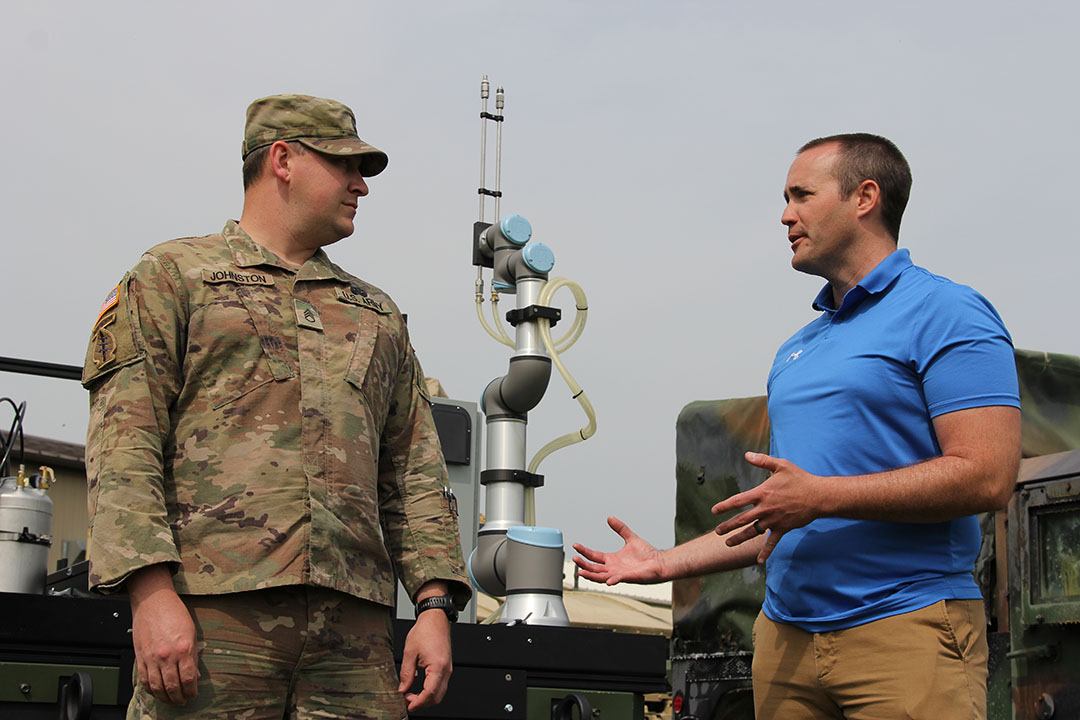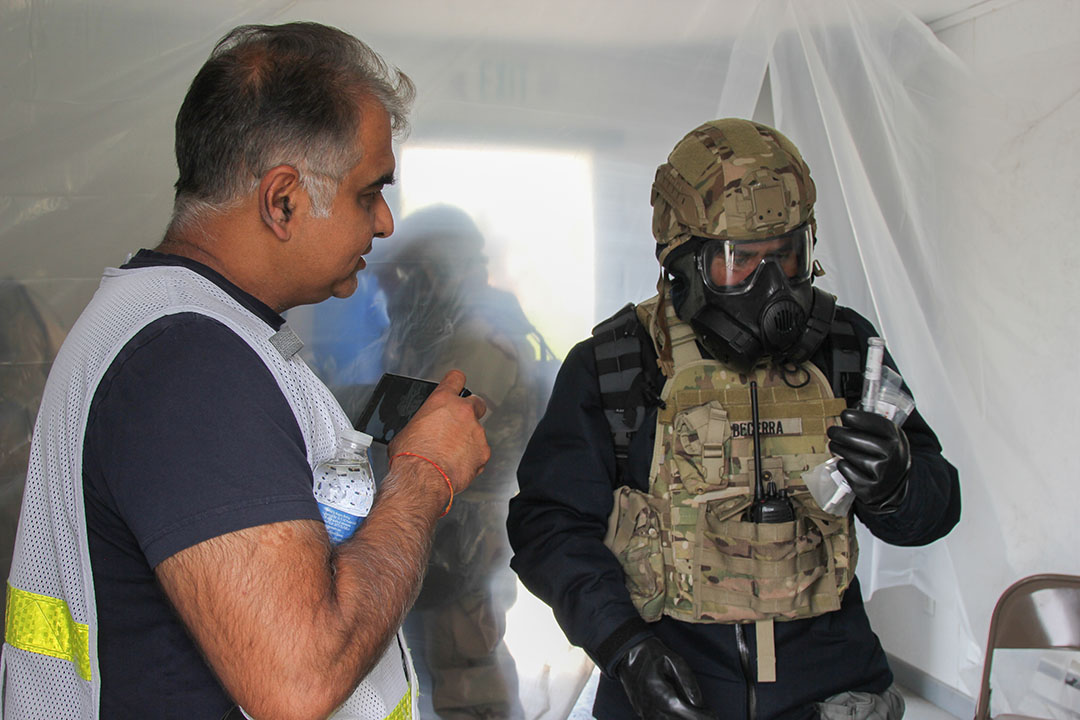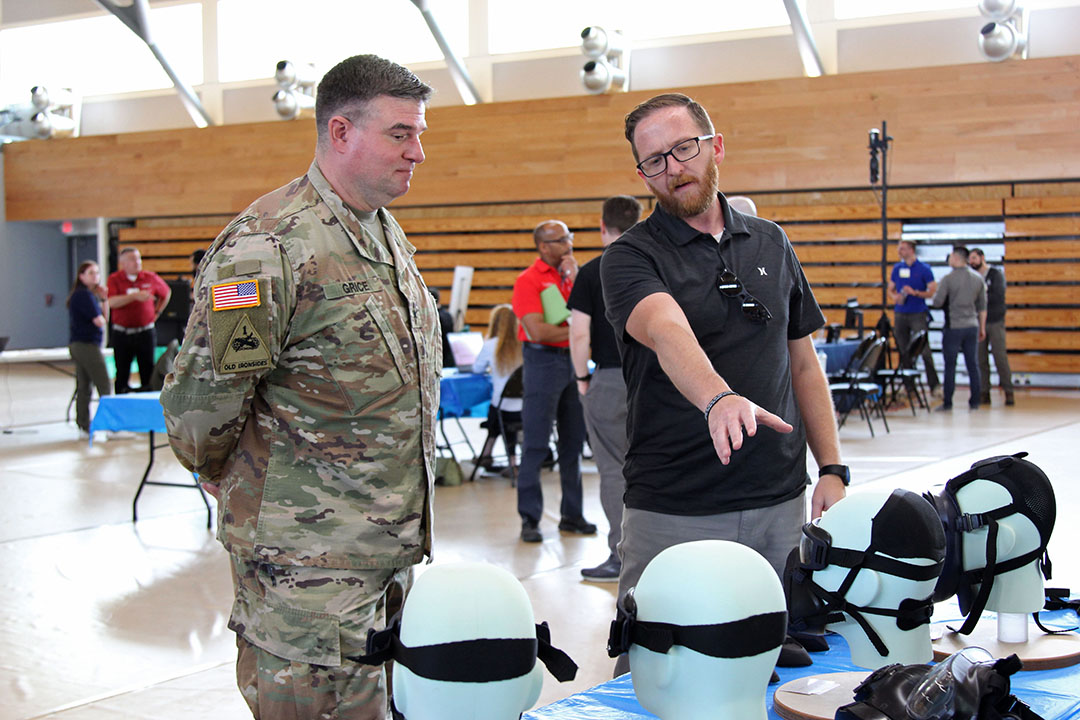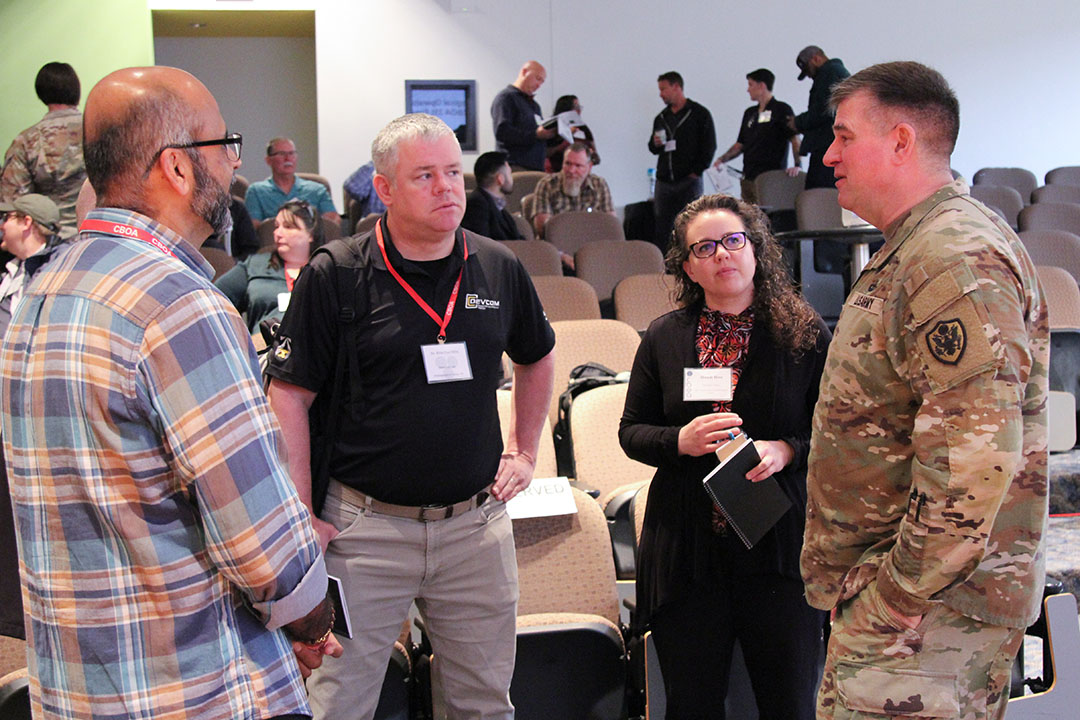// NEWS RELEASE
DEVCOM CBC Solutions Showcased at DTRA Technology Event
Autonomous Equipment Decontamination performs first field demonstration
CCDC Chemical Biological Center Public Affairs | June 26th, 2023
DEVCOM CBC Solutions Showcased at DTRA Technology Event
Autonomous Equipment Decontamination performs first field demonstration
DEVCOM CBC Public AffairsJune 26th, 2023
A UGV and custom-designed equipment controlled by remote operators decontaminates chemical agent simulant from a combat vehicle in a technology demonstration during CBOA 23 at Camp Dawson, West Virginia on May 11. (U.S. Army photo by Ellie White)
Aberdeen Proving Ground, MD — Several chemical and biological defense solutions developed at the U.S. Army Combat Capabilities Development Command Chemical Biological Center (DEVCOM CBC) were featured at a technology demonstration hosted by the Defense Threat Reduction Agency (DTRA) May 8-12. The star of the show was an autonomous equipment decontamination system DEVCOM CBC is developing in conjunction with DEVCOM and industry partners.
DTRA established the Chemical and Biological Operational Analysis (CBOA) in 2018 to bring chemical biological defense technology developers and warfighters together to evaluate new technologies through field trials. Warfighter feedback provides technology developers with vital input to identify improvements and recognize shortfalls. The event was held at Camp Dawson, West Virginia.
Autonomous Equipment Decontamination is a multi-year cooperative project with the DEVCOM Ground Vehicle Systems Center (GVSC) and DEVCOM Army Research Laboratory (ARL) plus industry partner, Teledyne-FLIR. The project’s goal is to develop and demonstrate an autonomous field chemical biological decontamination system for vehicles on the modern battlefield.
The concept is to ultimately have unmanned ground vehicles (UGVs) and unmanned aerial vehicles (UAVs) working in concert, employing artificial intelligence/machine learning to map contamination on combat vehicles on the battlefield soon after exposure. They can then apply decontamination solution to only those parts of a vehicle exposed and use sensors to identify which exposed vehicles can stay in the fight and which ones need to retire from the battle for more intensive decontamination.
Currently, contaminated vehicles are decontaminated by warfighters close to the point of exposure. It takes dozens of warfighters in full protective gear spending 45 to 60 minutes
washing down each vehicle, using thousands of gallons of water and hundreds of gallons of decontaminant per vehicle.

Before a crowd of Department of Defense, interagency, private industry and international chemical and biological defense partners, the prototype system demonstrated its ability to move up to a contaminated vehicle and perform decontamination remotely with the system operators a safe distance away.
The crowd in attendance watched a UGV roll up to the combat vehicle. It carried an onboard contamination mapping sensor for detection and a robotic arm for applying decontaminant. The chemical agent sensor detected the contamination simulant applied to the vehicle earlier. A camera on the UGV mapped the precise areas of contamination, and a hose mounted on the robotic arm used the data generated by the camera to spray only the contaminated areas of the combat vehicle.
DEVCOM CBC, the project lead, designed the decontamination applicator and led the integration of the payloads mounted on the UGV. ARL developed the robotic arm prototype and autonomous behaviors. GVSC developed additional autonomous behaviors and the user interfaces required to conduct decontamination tasks from the UGV. Teledyne-FLIR developed the software for contamination mapping and data sharing between the mapping sensor and the robotic applicator.

DEVCOM CBC systems engineer, Matthew Brown, was the maestro who coordinated the demonstration. He was very pleased by its success, emphasizing that it was a team effort. “The teams from DEVCOM CBC, GVSC, ARL and Teledyne-FLIR all came together to take our prototype on the road and successfully pull off a field demonstration for the first time. CBC’s continued partnership with DTRA and the Joint Project Manager for Chemical, Biological, Radiological and Nuclear Protection have allowed the teams to demonstrate the initial proof of concept of a future envisioned capability.”
Autonomous Equipment Decontamination was only one of six DEVCOM CBC technologies involved in the event. Overall, CBOA organizers received 87 submissions which they whittled down to 30 technologies and four prototypes. Five of the 30 displayed technologies came from DEVCOM CBC, and Autonomous Equipment Decontamination was one of the four prototypes. Other DEVCOM CBC technologies on display covered the gamut of detection, protection and decontamination:
• Autonomous Biological Critical Area Disinfection uses the same UGV as Autonomous Equipment Decontamination to rapidly and autonomously apply a disinfectant to operationally critical areas such as portions of airports or seaports. This system employs an alternative disinfection solution which is under development as part of this project. The disinfectant will be commercially available and imposes less logistical burden.
• Next Generation Respiratory Protection is a streamlined M50 mask that can be
modularized using filters offering different levels of protection to step up levels of protection to meet the anticipated threat level.

• BioACER is a fully automated aerosol collector, sample preparation and biological identifier that can handle 17 targets simultaneously. The automated process can be remotely triggered over a radio network, and the system analyzes the samples internally within ten minutes. Multiple BioACER devices were deployed on a UAV, a UGV, and carried in a warfighter’s pocket.
• Portable Sampling Identification of Trace Elements is an adhesive paper used by a person in MOPP 4 gear to gather a chemical or biological agent sample, place it in an airtight bag, and take it to a forward-deployed mass spectrometer which provides analysis results in less than 30 seconds.
• Dial-a-Threat Assay is a pocket-size biological agent screening device that can be operated by untrained people in the field. They swab a sample on to a credit-card size module that can analyze a sample in 15 to 30 minutes using a colorimetric readout.

CBOA has steadily grown in size and importance over the last five years, and DEVCOM CBC’s participation has grown in step. The DTRA project manager for the event, Markham Smith, said, “We truly thank DEVCOM CBC for its continued support. They have been with us since the beginning and every step of the way to ensure the event is a success and provides value to the Chemical and Biological Defense Program (CBDP) community.”
DEVCOM CBC personnel also participate in CBOA as technology evaluators, event coordinators and technology analysts. It is a true partnership in every sense according to DEVCOM CBC Research & Operations Director Dr. Frederick Cox. “CBC support to CBOA grows organically each year, and we greatly value it because CBOA fills a niche in the CBDP community by evaluating new technologies early on in collaboration with warfighters.” He added that, “One CBC technology featured this year, autonomous decontamination, was developed in partnership with multiple CBDP stakeholders including DTRA. It uses artificial intelligence and robotics to remove the warfighter from having to labor with contaminated equipment during decontamination. That speeds throughput to get that equipment back in the fight”.”
DEVCOM CBC leaders, along with bench scientists and engineers, look forward to CBOA 24 to demonstrate further technology developments and receive that all-important warfighter feedback.
The U.S. Army Combat Capabilities Development Command (DEVCOM) leads in the discovery, development and delivery of technology-based capabilities to enable Soldiers to win our nation’s wars and come home safely. DEVCOM is a major subordinate command of the U.S. Army Futures Command. The DEVCOM Chemical Biological Center is the Army’s principal research and development center for chemical and biological defense technology, engineering and field operations. The DEVCOM Chemical Biological Center is headquartered at Aberdeen Proving Ground, Maryland.
